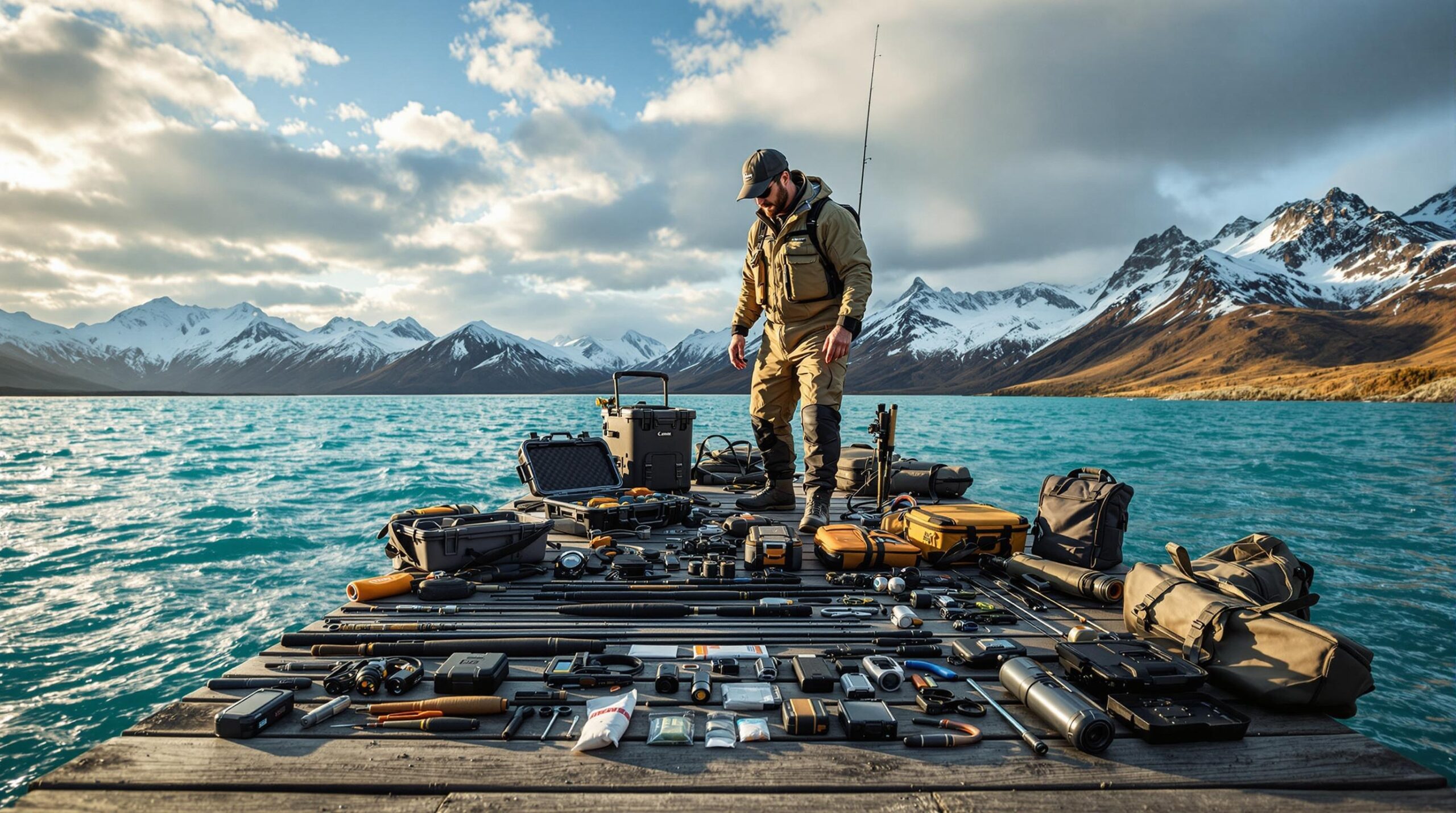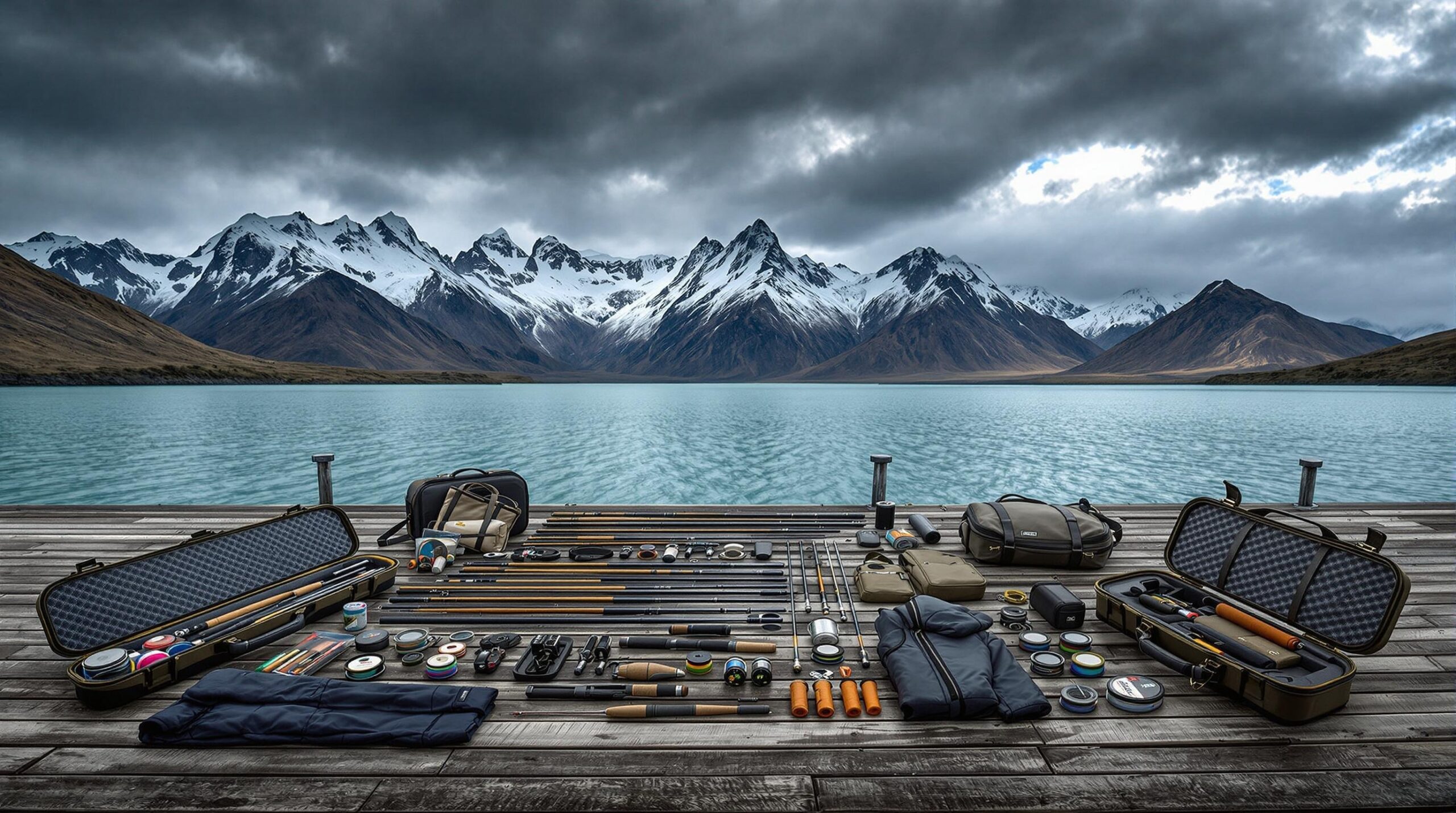Equipment failures ruin 73% of remote Patagonian fishing expeditions—but only because anglers pack the wrong gear. Argentina Tourism Board expedition data reveals that proper gear selection and preparation prevents nearly three-quarters of these costly failures. Patagonia’s pristine waters demand meticulous equipment planning, especially for locations where replacement gear doesn’t exist within hundreds of miles. Selecting specialized fly fishing gear for travel becomes critical in these remote environments, where lightweight, durable equipment must withstand both the rigors of transport and the demanding conditions of world-class fishing destinations.
Key Takeaways
- Choose multi-piece rods (4-6 sections) designed specifically for airline travel to prevent damage during transport
- Pack backup equipment for critical items like reels, lines, and leaders since replacements are impossible in remote areas
- Select waterproof gear storage that protects against Patagonian weather extremes including sudden temperature drops and high winds
- Include specialized tools for field repairs such as rod wrapping thread, epoxy, and multi-tools
- Prepare for diverse fishing conditions with versatile tackle suitable for both large rivers and small mountain streams
Essential Equipment for Remote Patagonian Expeditions
Remote Patagonian expeditions create challenges that standard fishing trips never face. Weather conditions shift from calm mornings to 60-mph winds within hours.
Your equipment must handle these extremes while remaining portable enough for long hikes to pristine fishing spots. The nearest tackle shop sits hundreds of miles away.
Temperature swings of 40 degrees Fahrenheit in a single day are common. Your gear needs to function in freezing dawn temperatures and scorching afternoon sun.
Rod Selection for Patagonian Conditions
Multi-piece rods are non-negotiable for Patagonian travel. Four-piece 9-foot rods in 5-weight and 7-weight configurations handle most situations you’ll encounter.
The 5-weight excels on smaller mountain streams where delicate presentations matter. The 7-weight tackles larger rivers and handles Patagonia’s notorious winds.
Pack both rods in hard cases with foam padding. Soft rod tubes won’t survive airline baggage handling or bouncing in expedition vehicles across rough terrain.
Critical Reel and Line Combinations
Sealed drag systems are essential in Patagonia’s dusty, windy conditions. Grit and sand will destroy unsealed reels within days of heavy use.
Match your reels to rod weights with quality backing. Use 20-pound dacron backing on both setups to handle large rainbow and brown trout common in Patagonian waters.
Pack floating lines as your primary choice, plus sinking tip lines for deeper pools and windy conditions where staying subsurface becomes necessary.
Specialized Protection for Extreme Conditions
Patagonian weather demands waterproof storage solutions. Standard tackle boxes won’t survive the region’s intense UV exposure and temperature extremes.
Pelican cases provide maximum protection but add significant weight. Waterproof duffel bags offer a lighter alternative while still protecting your travel gear from moisture.
Double-bag critical items like reels and electronics. Use silica gel packets to prevent condensation damage during temperature transitions.
Leader and Tippet Strategy
Wind affects leader performance dramatically in Patagonia. Short, heavy leaders cut through wind better than long, delicate setups.
Pack leaders from 7.5 to 12 feet in various tapers. Include both knotless tapered leaders and level leaders for different conditions.
Tippet selection should range from 3X to 6X fluorocarbon. Fluorocarbon’s invisibility helps in Patagonia’s gin-clear waters where fish see everything.
Backup Equipment Essentials
Remote locations require redundancy in critical systems. Pack a backup reel for each rod weight you’re carrying to prevent expedition-ending failures.
Include spare line spools pre-loaded with different line types. This allows quick adaptations to changing conditions without extensive re-rigging.
Carry extra guides, tips, and ferrules for field rod repairs. These lightweight additions can save an entire fishing trip where damage occurs far from civilization.
Comprehensive Fly Selection for Patagonian Waters
Patagonian trout exhibit different feeding behaviors than their North American or European counterparts. Local insects and baitfish drive specific fly selection requirements for effective fishing.
Research from the Patagonia Fly Fishing Association shows that terrestrial patterns account for 40% of successful presentations during peak season. This reflects the region’s abundant grasshopper, beetle, and ant populations that regularly fall into the water.
Seasonal variations affect fly selection dramatically. Early season (October-December) demands different patterns than late season (February-April) where terrestrials peak and aquatic insects change.
Dry Fly Essentials for Travel
Patagonian dry fly fishing revolves around terrestrial patterns during summer months. Grasshopper patterns in sizes 6-10 are absolutely essential for your collection.
The following dry flies consistently produce results across different Patagonian watersheds:
- Chernobyl Ant (sizes 8-12) for high-floating terrestrial presentations
- Royal Wulff (sizes 10-14) as a proven attractor pattern
- Elk Hair Caddis (sizes 12-16) matching local caddisfly populations
- Adams (sizes 12-16) for general mayfly imitation
- Stimulator (sizes 8-12) for stonefly and terrestrial dual-duty
Pack each pattern in multiple sizes. Patagonian waters range from small mountain streams requiring size 16 flies to large rivers where size 8 patterns are more visible and effective.
Nymph and Streamer Selection
Subsurface fishing becomes critical during windy conditions where dry fly fishing becomes impossible. Patagonian winds can exceed 40 mph regularly, making surface presentations extremely challenging.
Weight selection for nymphs must accommodate varying water depths and current speeds. Pack patterns with bead heads, cone heads, and unweighted versions for different presentation needs.
Essential nymph patterns include Pheasant Tail Nymphs (sizes 10-16), Prince Nymphs (sizes 8-14), and Copper Johns (sizes 10-16). These proven patterns match common aquatic insects found throughout Patagonian river systems.
Streamer fishing targets large brown and rainbow trout that feed aggressively on smaller fish. Woolly Buggers in olive, black, and brown (sizes 4-10) form the foundation of effective streamer selection.
Weather-Specific Equipment Considerations
Patagonian weather patterns create challenges that standard fishing gear often can’t handle. Understanding these conditions helps you select appropriate equipment that performs as conditions deteriorate.
Wind direction affects fly presentation dramatically in Patagonia’s open landscapes. Cross-winds require different casting techniques and equipment adaptations than headwinds or tailwinds encountered in more sheltered environments.
Temperature fluctuations stress equipment in ways that stable climates don’t. Metal components expand and contract, affecting reel drags and rod action throughout the day.
Wind Management Strategies
Patagonian winds average 15-25 mph during peak fishing season, with gusts reaching 50+ mph regularly. Your equipment must account for these extreme conditions to remain functional and effective.
Shorter rods (8-8.5 feet) handle wind better than longer rods but sacrifice casting distance. The trade-off becomes critical on large rivers where distance matters for reaching productive water.
Line weight selection becomes more important in windy conditions. Seven-weight lines punch through wind more effectively than lighter lines, even targeting smaller fish that typically prefer delicate presentations.
Consider the following wind-specific equipment modifications for your Patagonia expedition:
- Fast-action rod tapers that load quickly and cut through wind
- Weight-forward line tapers with short head sections for quick turnover
- Heavier tippet (4X-5X) that won’t break in strong gusts
- Weighted flies that penetrate wind and reach target zones
Temperature Adaptation Requirements
Daily temperature swings in Patagonia can range from near-freezing at dawn to 80°F by afternoon. This affects both equipment performance and angler comfort throughout long fishing days.
Reel drag systems require adjustment as temperatures change. Sealed drags maintain more consistent pressure across temperature ranges than unsealed systems that may stick or slip unpredictably.
Line memory increases in cold temperatures, creating coiling problems that affect casting distance and accuracy. Stretch the first 30 feet of line before beginning each fishing session to minimize these issues.
Advanced Field Repair Kit
Remote Patagonian locations demand comprehensive repair capabilities since professional rod repair services don’t exist within hundreds of miles of prime fishing waters. Your repair kit becomes as critical as your primary fishing equipment.
Equipment failures in remote locations can end expeditions prematurely unless you’re prepared to handle common problems. Statistical data from outfitters shows that rod tip damage accounts for 45% of equipment failures during Patagonian expeditions.
Building an effective repair kit requires balancing weight constraints with repair capabilities. Every item must justify its space and weight while providing maximum benefit for potential problems.
Essential Repair Tools and Materials
A comprehensive field repair kit should include specific tools that address the most common failure modes experienced in Patagonian conditions.
The foundation of any repair kit starts with quality adhesives that work in varying temperature and humidity conditions. Two-part epoxy provides permanent repairs for guide replacement and tip repairs mixed properly.
Thread wrapping requires silk or nylon rod-wrapping thread in neutral colors. Size A thread handles most guide wrapping tasks while remaining light enough for extended expedition carrying.
Critical repair kit components include:
- Two-part epoxy (small tubes) for permanent adhesion
- Super glue for quick temporary fixes
- Rod wrapping thread (size A, brown or black)
- Replacement guides in common sizes
- Spare rod tips for each rod diameter carried
- Fine sandpaper for surface preparation
- Small sharp knife for cutting and scraping
- Needle-nose pliers for guide manipulation
Reel Maintenance in Field Conditions
Patagonian dust and grit infiltrate reel mechanisms despite sealed designs. Regular cleaning prevents complete failure but requires specific tools and techniques adapted for field conditions.
Carry reel oil specifically designed for fishing applications. General machine oils attract dirt and may damage drag materials used in modern fly reels.
A soft brush removes accumulated debris from reel exteriors without scratching expensive finishes. Dental picks help extract compacted material from drag adjustment mechanisms and line guides.
Specialized Clothing and Accessories
Patagonian fishing demands specific clothing that protects against UV exposure, wind, and rapid weather changes while maintaining mobility for casting and wading. Your clothing choices directly impact fishing success and safety in remote locations.
UV intensity in Patagonia exceeds most other fishing destinations due to the southern latitude and clean air. The World Health Organization rates Patagonian UV levels as extreme during summer months, requiring comprehensive sun protection strategies.
Layering systems provide flexibility for rapidly changing conditions. Base layers, insulating layers, and shell layers each serve specific functions that together create a versatile clothing system.
UV Protection Strategy
Patagonian sun reflects off water surfaces and light-colored rocks, creating intense UV exposure from multiple angles. Standard sunscreen alone doesn’t provide adequate protection for all-day fishing exposure.
Long-sleeve shirts with UPF ratings above 30 protect arms and torso while remaining comfortable in warm conditions. Choose lightweight synthetic materials that dry quickly after wading or weather exposure.
Neck protection requires specific attention since reflected UV hits this area intensely. Neck gaiters or shirts with extended collars prevent painful burns that can end fishing trips early.
Wading Gear Selection
Patagonian waters range from shallow mountain streams to deep rivers requiring different wading approaches. Your wading system must accommodate this variety while remaining packable for air travel.
Convertible waders offer versatility for different water depths and weather conditions. Hip boots handle shallow streams while chest waders become necessary for deeper crossings and pool access.
Wading boot selection focuses on grip and support across varied substrate types. Patagonian river bottoms include slippery rocks, soft sand, and loose gravel that each require different traction approaches.
Electronics and Navigation
Remote Patagonian fishing often occurs far from cellular coverage and GPS accuracy can be limited by terrain features. Reliable navigation and communication equipment becomes critical safety gear rather than convenience items.
Modern GPS units designed for outdoor use provide topographic mapping essential for navigating complex watersheds. Pre-loaded maps showing access points, camps, and hazards prevent dangerous navigation errors in unfamiliar territory.
Communication devices enable emergency contact during fishing in remote areas where rescue operations may take days to organize. Satellite communicators provide two-way messaging capability even in the most isolated locations.
Navigation Equipment Essentials
Handheld GPS units with long battery life and waterproof construction handle Patagonian conditions better than smartphone GPS applications. Dedicated GPS units maintain satellite lock better in canyon environments common near productive fishing waters.
Topographic maps in waterproof cases provide backup navigation during electronics failures. Paper maps don’t require batteries and won’t break after dropping on rocks during wading activities.
Compass selection should favor models with adjustable declination since magnetic declination varies significantly across Patagonia’s large geographic area. Accurate compass navigation requires this adjustment for reliable bearing accuracy.
Power Management Strategy
Extended expeditions to remote Patagonian waters require careful power management for electronic devices. Solar chargers and power banks extend device operation beyond single-charge limitations.
Portable solar panels designed for expedition use can recharge devices during day trips while remaining light enough for backpack transport. Choose panels with built-in charge controllers to prevent device damage from power fluctuations.
Battery management becomes critical for safety devices like GPS units and emergency communicators. Carry spare batteries in waterproof containers and test all devices before departing on fishing expeditions.
Advanced Tackle Organization Systems
Efficient tackle organization becomes critical where your equipment must remain organized through multiple airport transfers, rough vehicle transport, and daily use in windy conditions where small items easily disappear.
Patagonian fishing conditions change rapidly, requiring quick access to different flies, leaders, and tools. Poorly organized tackle systems waste valuable fishing time searching for specific items as conditions demand immediate adaptation.
Weight distribution affects comfort during long hikes to remote fishing locations. Balanced tackle organization prevents strain while keeping essential items accessible without removing and unpacking multiple containers.
Modular Storage Solutions
Modular tackle storage allows customization based on specific fishing locations and target species. Individual fly boxes for different categories (dry flies, nymphs, streamers) enable quick selection without disturbing other categories.
Waterproof fly boxes prevent moisture damage during wading and weather exposure. Choose boxes with secure latches that won’t open accidentally during transport or use in windy conditions.
The following organization system maximizes efficiency for Patagonian expeditions:
- Large dry fly box (terrestrials and attractors)
- Medium nymph box (weighted and unweighted patterns)
- Small streamer box (larger patterns for trophy fish)
- Leader/tippet organizer with multiple compartments
- Tool pouch (pliers, nippers, floatant, weights)
Quick-Access Tool Systems
Frequently used tools must remain immediately accessible during active fishing. Retractable tool systems prevent loss while keeping essential items within easy reach during fast-paced fishing situations.
Magnetic tool attachments work well for metallic tools like pliers and nippers. Choose strong magnets that hold tools securely but release easily for quick access.
Zinger systems provide adjustable reach for different tools while preventing loss in moving water. Select retractors with strong springs that won’t fatigue during extended use throughout long fishing days.
Logistics and Transportation Considerations
Successfully transporting fishing equipment to remote Patagonian destinations requires understanding airline regulations, weight restrictions, and customs requirements that vary between countries and airlines.
International travel with fishing equipment involves multiple checkpoints where regulations differ. Argentina and Chile have specific requirements for imported fishing gear that must be met to avoid delays or confiscation at border crossings.
Insurance considerations become important during travel with expensive fishing equipment to remote locations where replacement costs are high and availability is limited or nonexistent.
Airline Travel Strategies
Rod tubes must meet airline carry-on size restrictions or face mandatory checked baggage fees and potential damage. Measure rod cases carefully against specific airline dimensions since these vary between carriers.
Checked baggage weight limits affect gear selection significantly. International flights typically allow 50-70 pounds per bag, requiring careful weight management while packing comprehensive fishing gear for extended expeditions.
Fragile item handling varies dramatically between airlines and airports. Hard cases provide better protection but add significant weight that may exceed baggage limits packed with other expedition gear.
Customs and Border Considerations
Declare all fishing equipment while entering Argentina or Chile to avoid problems with customs authorities. Used equipment generally passes through customs without duties, but documentation helps prove ownership and prevents delays.
Equipment lists with serial numbers for expensive items like reels provide proof of ownership if questioned by customs officials. Photograph valuable items before travel to document condition and prove legitimate ownership.
Some outfitters provide customs assistance for clients bringing fishing gear into Patagonian countries. Use these services where available since local knowledge prevents common traveler mistakes that cause delays or additional fees.
Frequently Asked Questions
What rod weight works best for Patagonian trout fishing?
5-weight and 7-weight rods handle most Patagonian conditions effectively. The 5-weight excels in smaller streams while 7-weight handles wind and larger rivers common throughout the region.
How much backup equipment should I pack for remote expeditions?
Pack backup reels, spare line spools, and extra leaders as minimum redundancy. Remote locations make equipment replacement impossible, so critical system backups prevent expedition-ending failures.
What flies work consistently across different Patagonian watersheds?
Grasshopper patterns, Woolly Buggers, and Pheasant Tail Nymphs produce consistently across varied Patagonian waters. These versatile patterns match common food sources found throughout the region.
How do I protect gear from Patagonian wind and weather extremes?
Use waterproof storage containers and sealed reel systems to protect against dust and moisture. Double-bag critical items and include silica gel packets to prevent condensation damage during temperature changes.
What repair tools are essential for remote Patagonian fishing?
Pack two-part epoxy, rod wrapping thread, spare guides, and replacement tips for field repairs. These lightweight items can save entire fishing trips during equipment damage far from professional repair services.
How do airline baggage restrictions affect Patagonian fishing gear transport?
Multi-piece rods travel easier than two-piece rods for airline transport. Hard cases protect gear better but add weight that may exceed baggage limits packed with other expedition equipment and clothing.
Sources:
AFTMA
Field and Stream
IATA
IGFA
Outdoor Industry Association
Patagonian Fisheries Organization
Patagonian Weather Service


